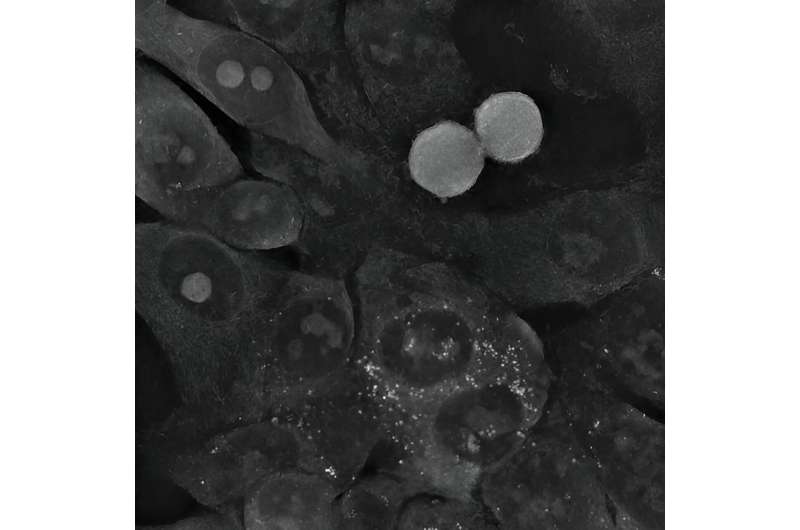Gold particles of the size of billionths of a meter are lethal to cancer cells. This fact has been known for a long time, as has a simple correlation: The smaller the nanoparticles used to fight the cancer cells, the faster they die. However, a more interesting, more complex picture of these interactions is emerging from the latest research, conducted at the Institute of Nuclear Physics of the Polish Academy of Sciences, using a novel microscopic technique.
Smaller kills faster—this is what was previously thought about gold nanoparticles used to fight cancer cells. Scientists thought that small nanoparticles would simply find it easier to penetrate the interior of a cancer cell, where their presence would lead to metabolic disturbances and ultimately cell death.
The reality, however, turns out to be more complex, as demonstrated by research carried out by scientists from the Institute of Nuclear Physics of the Polish Academy of Sciences (IFJ PAN) in Cracow, supported by theoretical analysis performed at the University of Rzeszow (UR) and Rzeszow University of Technology.
“Our institute operates a state-of-the-art medical and accelerator center for proton radiotherapy. So when reports emerged a few years ago that gold nanoparticles could be good radiosensitizers and enhance the effectiveness of this sort of therapy, we started to synthesize them ourselves and test their interaction with cancer cells. We quickly found out that the toxicity of nanoparticles was not always as expected,” says Dr. Joanna Depciuch-Czarny (IFJ PAN), initiator of the research and first author of an article discussing the results, published in the journal Small.
Nanoparticles can be produced using a variety of methods, yielding particles of different sizes and shapes. Shortly after starting their own experiments with gold nanoparticles, the IFJ PAN physicists noticed that biology does not follow the popular rule that their toxicity is greater the smaller they are.
Spherical nanoparticles of 10 nanometers in size, produced in Cracow, turned out to be practically harmless to the glioma cell line studied. However, high mortality was observed in cells exposed to nanoparticles as large as 200 nanometers, but with a star-shaped structure.
Elucidation of the stated contradiction became possible thanks to the use of the first holotomographic microscope in Poland, at IFJ PAN.
A typical CT scanner scans the human body using X-rays, and reconstructs its spatial internal structure section by section. In biology, a similar function has recently been performed by the holotomographic microscope. Here, cells are also swept by a beam of radiation, though not high-energy radiation, but electromagnetic radiation. Its energy is chosen so that the photons do not disturb cell metabolism.
The result of the scan is a set of holographic cross-sections containing information about the distribution of refractive index changes. Since light refracts differently on the cytoplasm and differently on the cell membrane or nucleus, it is possible to reconstruct a three-dimensional image of both the cell itself and its interior.
“Unlike other high-resolution microscopy techniques, holotomography does not require the preparation of samples or the introduction of any foreign substances into the cells. The interactions of gold nanoparticles with cancer cells could therefore be observed directly in the incubator, where the latter were cultured, in an undisturbed environment–what’s more, with nanometric resolution–from all sides simultaneously and practically in real time,” enumerates Dr. Depciuch-Czarny.
The unique features of holotomography allowed the physicists to determine the causes of the unexpected behavior of cancer cells in the presence of gold nanoparticles. A series of experiments was conducted on three cell lines: two glioma and one colon. Among others, it was observed that although the small, spherical nanoparticles easily penetrated the cancer cells, the cells regenerated and even started to divide again, despite the initial stress.

In the case of colon cancer cells, the gold nanoparticles were quickly pushed out of them. The situation was different for the large star-shaped nanoparticles. Their sharp tips perforated the cell membranes, most likely resulting in increasing oxidative stress inside the cells. When these cells could no longer cope with repairing the increasing damage, the mechanism of apoptosis, or programmed death, was triggered.
“We used the data from the Cracow experiments to build a theoretical model of the process of nanoparticle deposition inside the cells under study. The final result is a differential equation into which suitably processed parameters can be substituted—for the time being only describing the shape and size of nanoparticles—to quickly determine how the uptake of the analyzed particles by cancer cells will proceed over a given period of time,” says Dr. Pawel Jakubczyk, professor at the UR and co-author of the model.
He emphasizes, “Any scientist can already use our model at the design stage of their own research to instantly narrow down the number of nanoparticle variants requiring experimental verification.”
The ability to easily reduce the number of potential experiments to be carried out means a reduction in the costs associated with the purchase of cell lines and reagents, as well as a marked reduction in research time (it typically takes around two weeks just to culture a commercially available cell line). In addition, the model can be used to design better-targeted therapies than before—ones in which the nanoparticles will be particularly well absorbed by selected cancer cells, while maintaining relatively low or even zero toxicity to healthy cells in the patient’s other organs.
The Cracow-Rzeszow group of scientists is already preparing to continue their research. New experiments should soon make it possible to extend the model of the interaction of nanoparticles with cancer cells to include further parameters, such as the chemical composition of the particles or further tumor types. Later plans also include supplementing the model with mathematical elements to optimize the efficacy of photo- or proton therapy for indicated combinations of nanoparticles and tumors.
More information: Joanna Depciuch et al, Modeling Absorption Dynamics of Differently Shaped Gold Glioblastoma and Colon Cells Based on Refractive Index Distribution in Holotomographic Imaging, Small (2024). DOI: 10.1002/smll.202400778
Journal information: Small
Provided by Polish Academy of Sciences
News
A single shot of HPV vaccine may be enough to fight cervical cancer, study finds
WASHINGTON -- A single HPV vaccination appears just as effective as two doses at preventing the viral infection that causes cervical cancer, researchers reported Wednesday. HPV, or human papillomavirus, is very common and spread [...]
New technique overcomes technological barrier in 3D brain imaging
Scientists at the Swiss Light Source SLS have succeeded in mapping a piece of brain tissue in 3D at unprecedented resolution using X-rays, non-destructively. The breakthrough overcomes a long-standing technological barrier that had limited [...]
Scientists Uncover Hidden Blood Pattern in Long COVID
Researchers found persistent microclot and NET structures in Long COVID blood that may explain long-lasting symptoms. Researchers examining Long COVID have identified a structural connection between circulating microclots and neutrophil extracellular traps (NETs). The [...]
This Cellular Trick Helps Cancer Spread, but Could Also Stop It
Groups of normal cbiells can sense far into their surroundings, helping explain cancer cell migration. Understanding this ability could lead to new ways to limit tumor spread. The tale of the princess and the [...]
New mRNA therapy targets drug-resistant pneumonia
Bacteria that multiply on surfaces are a major headache in health care when they gain a foothold on, for example, implants or in catheters. Researchers at Chalmers University of Technology in Sweden have found [...]
Current Heart Health Guidelines Are Failing To Catch a Deadly Genetic Killer
New research reveals that standard screening misses most people with a common inherited cholesterol disorder. A Mayo Clinic study reports that current genetic screening guidelines overlook most people who have familial hypercholesterolemia, an inherited disorder that [...]
Scientists Identify the Evolutionary “Purpose” of Consciousness
Summary: Researchers at Ruhr University Bochum explore why consciousness evolved and why different species developed it in distinct ways. By comparing humans with birds, they show that complex awareness may arise through different neural architectures yet [...]
Novel mRNA therapy curbs antibiotic-resistant infections in preclinical lung models
Researchers at the Icahn School of Medicine at Mount Sinai and collaborators have reported early success with a novel mRNA-based therapy designed to combat antibiotic-resistant bacteria. The findings, published in Nature Biotechnology, show that in [...]
New skin-permeable polymer delivers insulin without needles
A breakthrough zwitterionic polymer slips through the skin’s toughest barriers, carrying insulin deep into tissue and normalizing blood sugar, offering patients a painless alternative to daily injections. A recent study published in the journal Nature examines [...]
Multifunctional Nanogels: A Breakthrough in Antibacterial Strategies
Antibiotic resistance is a growing concern - from human health to crop survival. A new study successfully uses nanogels to target and almost entirely inhibit the bacteria P. Aeruginosa. Recently published in Angewandte Chemie, the study [...]
Nanoflowers rejuvenate old and damaged human cells by replacing their mitochondria
Biomedical researchers at Texas A&M University may have discovered a way to stop or even reverse the decline of cellular energy production—a finding that could have revolutionary effects across medicine. Dr. Akhilesh K. Gaharwar [...]
The Stunning New Push to Protect the Invisible 99% of Life
Scientists worldwide have joined forces to build the first-ever roadmap for conserving Earth’s vast invisible majority—microbes. Their new IUCN Specialist Group reframes conservation by elevating microbial life to the same urgency as plants and [...]
Scientists Find a Way to Help the Brain Clear Alzheimer’s Plaques Naturally
Scientists have discovered that the brain may have a built-in way to fight Alzheimer’s. By activating a protein called Sox9, researchers were able to switch on star-shaped brain cells known as astrocytes and turn them into [...]
Vision can be rebooted in adults with amblyopia, study suggests
Temporarily anesthetizing the retina briefly reverts the activity of the visual system to that observed in early development and enables growth of responses to the amblyopic eye, new research shows. In the common vision [...]
Ultrasound-activated Nanoparticles Kill Liver Cancer and Activate Immune System
A new ultrasound-guided nanotherapy wipes out liver tumors while training the immune system to keep them from coming back. The study, published in Nano Today, introduces a biodegradable nanoparticle system that combines sonodynamic therapy and cell [...]
Magnetic nanoparticles that successfully navigate complex blood vessels may be ready for clinical trials
Every year, 12 million people worldwide suffer a stroke; many die or are permanently impaired. Currently, drugs are administered to dissolve the thrombus that blocks the blood vessel. These drugs spread throughout the entire [...]





















